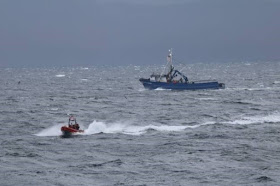Coast Guardsmen prepare bails of cocaine to be offloaded from the Coast Guard Cutter Alert in San Diego, October 16, 2019. The crew aboard the Alert offloaded approximately 6,800 pounds of cocaine.
Coast Guard photo by Petty Officer 3rd Class Alex Gray.
SAN DIEGO — The Coast Guard offloaded more than $92 million worth of seized cocaine in San Diego Wednesday.
The cocaine, worth more than $92 million, was seized in international waters of the Eastern Pacific Ocean. The contraband represents four suspected drug smuggling vessel interdictions by the crews of three Coast Guard cutters off the coasts of Mexico, Central and South America between late July and early October by the following Coast Guard cutters:
- Alert (WMEC-630) was responsible for two cases, seizing approximately 4,000 pounds of cocaine
- Robert Ward (WPC-1130) was responsible for one case, seizing approximately 1,500 pounds of cocaine
- Seneca (WMEC-906) was responsible for one case, seizing approximately 1,400 pounds of cocaine
The Coast Guard Cutter Alert crew conducted a drug offload in San Diego, Oct. 16, 2019. The crew offloaded more than 6,800 pounds of cocaine, worth an estimated $92 million, seized in the Eastern Pacific Ocean.
Coast Guard photo by Petty Officer 3rd Class Alex Gray.
Numerous U.S. agencies from the Departments of Defense, Justice and Homeland Security are involved in the effort to combat transnational organized crime. The Coast Guard, Navy, Customs and Border Protection, FBI, Drug Enforcement Administration and Immigration and Customs Enforcement along with allied and international partner agencies play a role in counter-drug operations. The fight against transnational organized crime networks in the Eastern Pacific requires unity of effort in all phases from detection, monitoring and interdictions to prosecutions by U.S. Attorneys throughout the country.
"I am extremely proud of this crew for doing their part to keep these dangerous drugs off the streets," said Cmdr. Tyson Scofield, Alert’s commanding officer. "The Eastern Pacific Ocean is a challenging environment, especially on a ship that is in her 50th year of service, yet this crew persevered to disrupt the illegal flow of narcotics that fuels instability in Central and South America. The counter-drug mission is as important now as it has ever been, and these brave men and women can return home after a 69-day patrol knowing they made a difference."
A suspected smuggling vessel drifts in international waters of the Eastern Pacific Ocean after being intercepted by the crew of the Coast Guard Cutter Alert in October. Approximately 2,000 pounds of cocaine were seized and three suspected smugglers were detained.
U.S. Coast Guard photo.
The Coast Guard increased the U.S. and allied presence in the Eastern Pacific Ocean and Caribbean Basin, which are known drug transit zones off of Central and South America, as part of its Western Hemisphere Strategy. During at-sea interdictions in international waters, a suspect vessel is initially located and tracked by allied, military or law enforcement personnel. The interdictions, including the actual boarding, are led and conducted by U.S. Coast Guardsmen. The law enforcement phase of counter-smuggling operations in the Eastern Pacific is conducted under the authority of the Coast Guard 11th District headquartered in Alameda.
Bales of cocaine lie stacked under the deck of a suspected smuggling vessel in October interdicted by the crew of the Coast Guard Cutter Alert in international waters of the Eastern Pacific Ocean. Approximately 2,000 pounds of cocaine were seized and three suspected smugglers were detained.
U.S. Coast Guard photo.
The Alert is a 210-foot medium-endurance cutter homeported in Astoria, Oregon. The Robert Ward is a 154-foot fast-response cutter homeported in San Pedro. The Seneca is a 270-foot medium-endurance cutter homeported in Boston, Massachusetts.
-USCG-


























